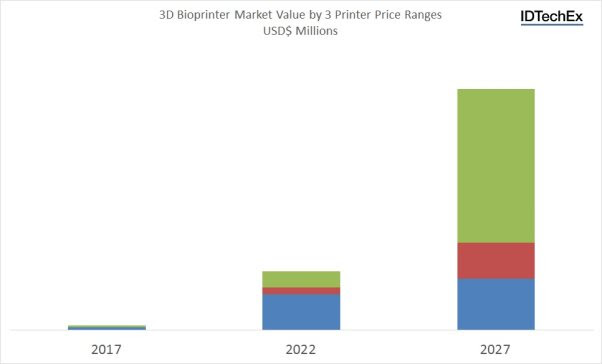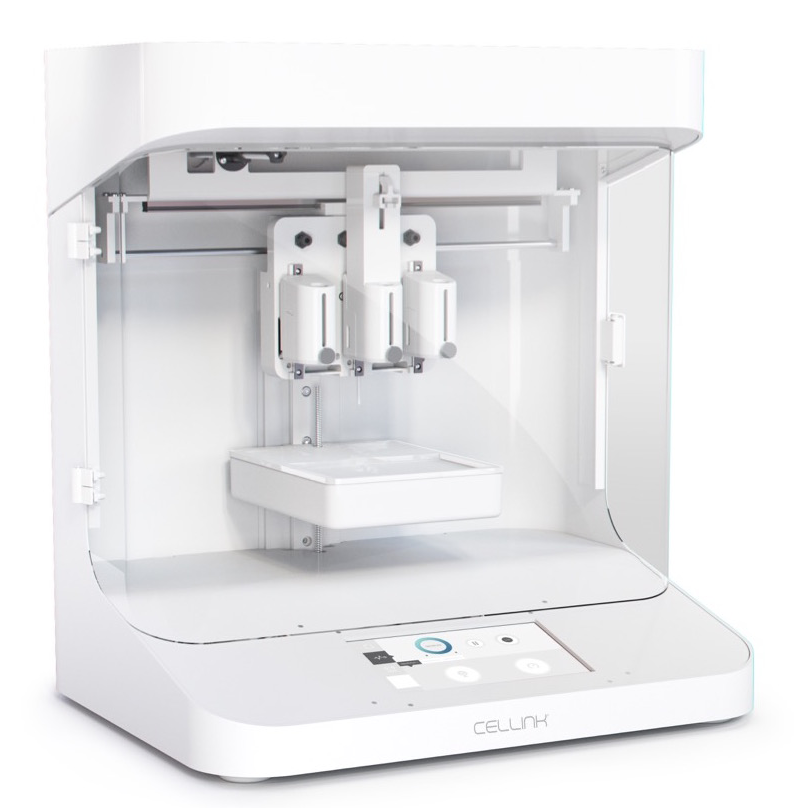The global 3D bioprinting market is set to reach $1.8 billion by the year 2027, market research firm IDTechEx has reported. This can be seen as a result of that, after over 15 years of research and development – according to the firm – several main applications of 3D bioprinting, such as regenerative medicine and cell-based biosensors, are ready to be realised.

Market projections for 3D Bioprinting. (Credit: IDTechEx)
Bioprinting refers to the layer-by-layer deposition of cells to produce artificial tissues that mimic natural tissues in both form and function. The technique can be used in regenerative medicine, the act of replacing damaged and failing human organs with artificially printed copies, with promising animal trials having been conducted over the past year. While regenerative medicine is not expected to be a significant market within the next 10 years, it has and will be a major influence on the 3D bioprinting market. The $1.8 billion forecast includes both demand for 3D bioprinters and 3D bioprinted tissues.
According to IDTechEx, the 3D bioprinting industry is set to expand rapidly over the next few years. ‘Commercial interest in 3D bioprinting has risen greatly – already the first four months of 2017 has seen the release of three new affordable 3D bioprinters from manufacturers Aether, BioBots, and Cellink.’ said Dr Nadia Tsao, technology analyst at the market research firm. Tsao also noted that over the past year, 3D bioprinting service bureaus have experienced significant growth and are partnering with several multi-national corporations in the consumer products and pharmaceutical industries.
Four of the main 3D bioprinting technologies are inkjet, extrusion, laser-induced forward transfer, and microvalve printheads. One market trend observed by IDTechEx is the increasing versatility of 3D bioprinters, which are now allowing users to easily incorporate several 3D bioprinting technologies into their products without needing multiple machines.
In addition to regenerative medicine being a potential 3D bioprinting application, the technology also has promise in the areas of testing of cosmetics and other consumer goods, drug screening for the pharmaceutical industry, personalised medicine, cell-based biosensors, food, education, academic research and bionics.
The growing success of 3D bioprinting can already be seen in the development of certain companies involved in the sector. Swedish startup Cellink produces low-cost, accessible 3D bioprinting technology, and has recently announced its opening of a new office in Cambridge, Massachusetts. The opening is a result of Cellink’s progression and growing relevance in the field of bioprinting, with the company now having its technology installed in hundreds of labs and offices in 30 different countries.

Cellink's BIO X 3D printer. (Credit: Cellink)
‘It's been insane,’ Cellink co-founder Erik Gatenholm told The Roanoke Times. ‘We're now starting to see customers publish work with this equipment, and it's amazing. I couldn't imagine a year ago that we'd be there.’
Swedish researchers have also recently announced in Scientific Reports, the successful 3D-printing of stem cells that are able to multiply and differentiate into a material very similar to human cartilage tissue. The research indicates a possible future where scientists can generate cartilage based off a patient's own stem cells, and use that cartilage in the patient's body. The researchers said that their 3D-bioprinted cartilage was so similar to human cartilage that experienced surgeons were unable to discern the two.
Back in 2013, Cornell University scientists were able to successfully use a 3D bioprinter to grow human ears from cow cells. It was claimed later that year that similar ears produced by Princeton University researchers could hear at frequencies far out of range of the normal human ear.

